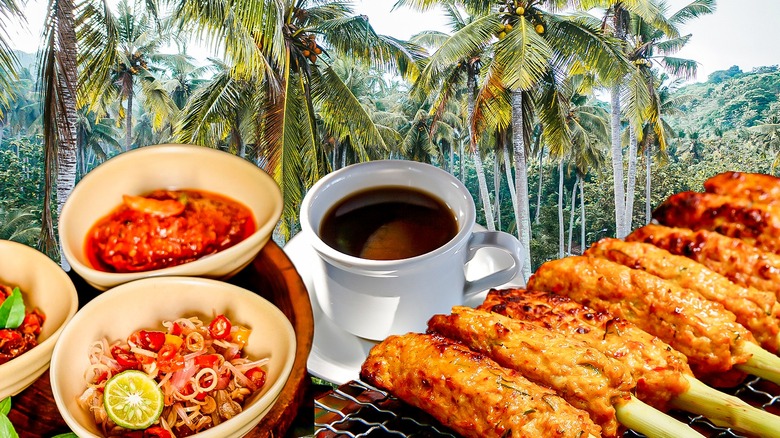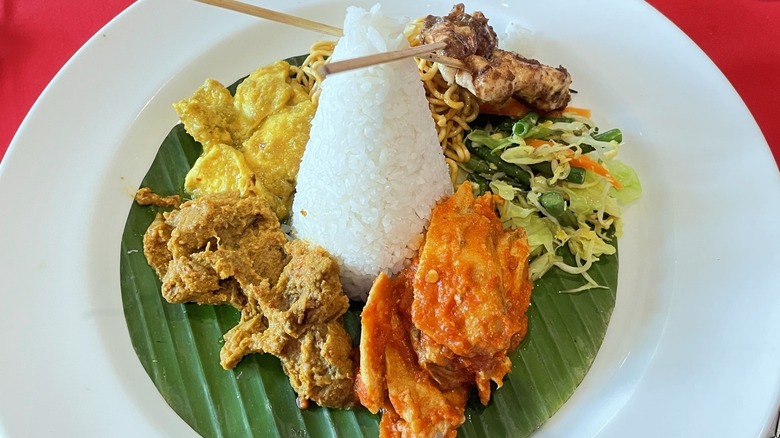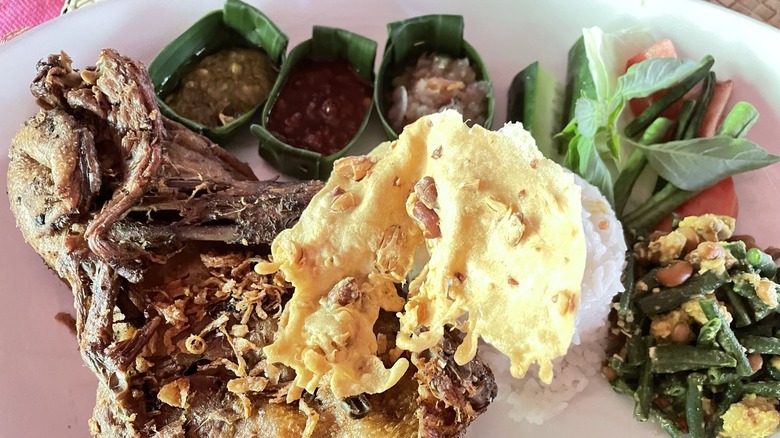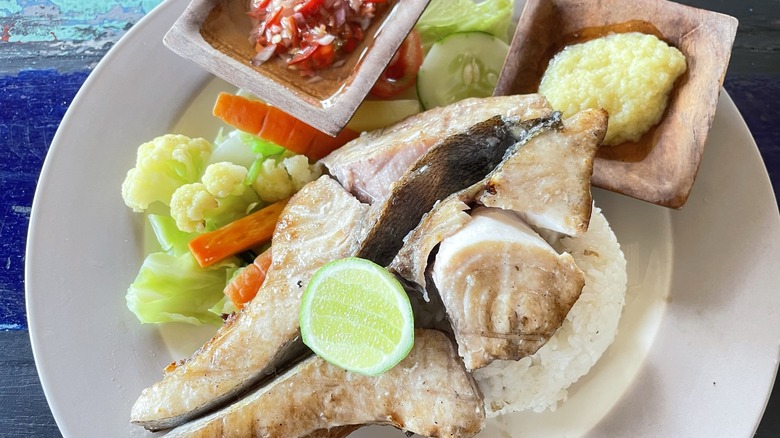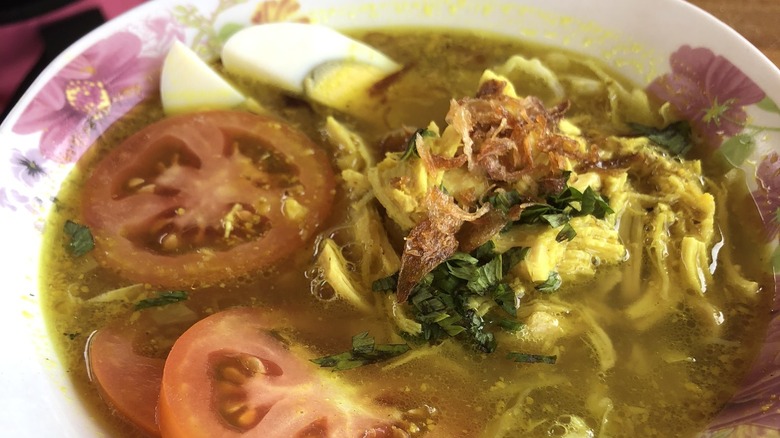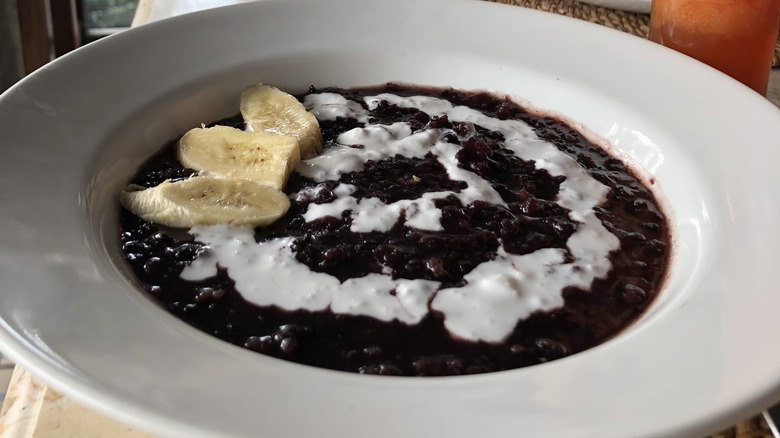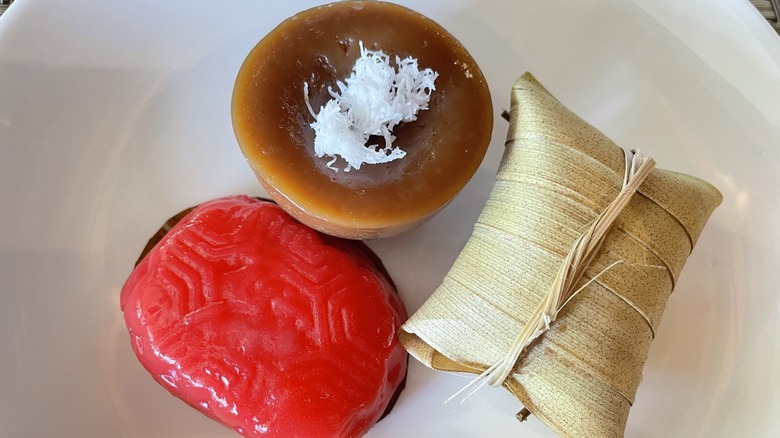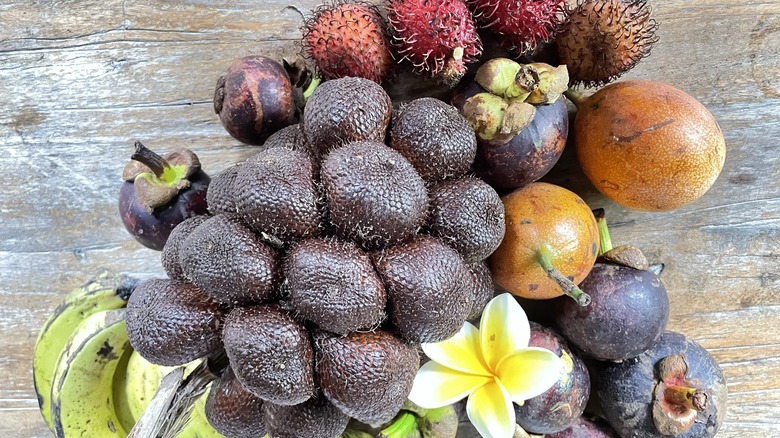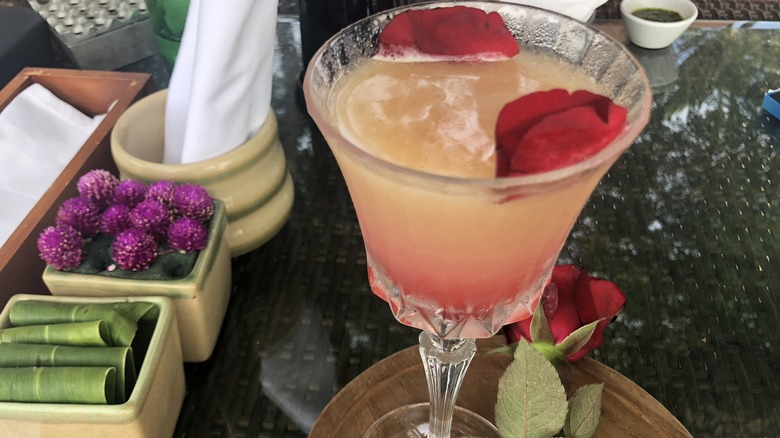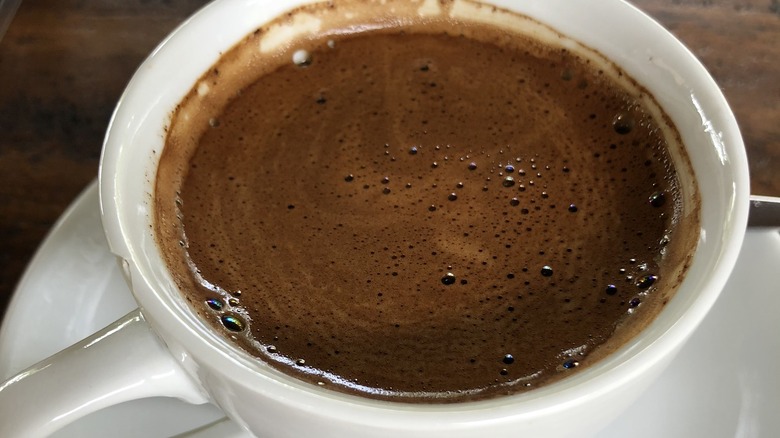15 Best Foods And Drinks To Try In Bali
When you think of Bali, the first images that come to mind are sandy beaches, palm trees, and blue horizons. And what's better to enjoy on the beach than a healthy and vibrantly colored smoothie bowl alongside a fresh cocktail?
Well, Bali is also home to spectacular traditional cuisine. The island's vibrant and unique culture is reflected in its food. There are several ceremonial desserts and dishes that carry special significance in local culture. Most of the island's foods can be characterized by combinations that create vibrant, exciting tastes. No matter how skilled you are in identifying flavors and ingredients, Balinese cuisine will baffle you in the best way possible. It's a display of countless tastes coming from common, familiar staples like cloves, lemongrass, coconut, chilies, cinnamon, and rice. Bali's food will make your head spin with aromas and will surely leave you wanting more. And hopefully, when you return home, you'll still feel a hint of lemongrass on the tastebuds of your memories.
Babi guling
One Balinese dish stands out, namely the famous babi guling, which translates to "suckling pig." Anthony Bourdain, the renowned chef and food writer, once called babi guling the "best pig ever" for a good reason. It is a delicious and unique dish that is a must-try for any food lover visiting Bali.
Perhaps the most famous place to try babi guling in Bali is the Ibu Oka restaurant in Ubud. The restaurant's version of the dish features tender roasted pork infused with a rich blend of herbs and spices. The ingredients include pork, turmeric, coriander seeds, lemongrass, garlic, ginger, and chili. The pork is roasted on a spit until it is crispy on the outside and juicy on the inside. It is then served with rice, crispy crackling, spicy sambal, and various vegetable sides, such as steamed cassava leaves and aromatic green beans. The combination of crispy, juicy pork and fragrant herbs and spices creates a flavor burst that will surely surprise and delight you. However, what's most surprising about this food is how the taste of pork (especially the crispy crackling) blends perfectly with the citrusy lemongrass.
Sate lilit
Another popular dish in Balinese cuisine is sate lilit. Unlike traditional satay, which is made from chunks of meat on skewers, sate lilit uses minced meat or fish mixed with various herbs and spices, then molded onto lemongrass or bamboo sticks before being grilled to perfection.
The most common version of Balinese sate lilit is made with fish, usually tuna or mackerel. The minced fish is mixed with grated coconut, lemongrass, garlic, and various spices, such as turmeric and galangal. This mixture is then molded onto the skewers and grilled until slightly charred and crispy on the outside. The taste of sate lilit is an explosion of flavors. The combination of fragrant spices and fresh fish creates a perfect balance of savoriness, intensely melding cloves, cinnamon, and tuna. In addition, the lemongrass adds a subtle aroma to the dish which enhances its overall taste. At Balique in Jimbaran, the sate lilit is served on lemongrass shoots, making it delicious as well as visually stunning. The dish is perfect as a starter or a snack and is a great way to experience the flavors of Bali.
Nasi campur
Nasi campur is a dish in Balinese cuisine that translates to "mixed rice." It is a plate of rice accompanied by various small dishes, including meat, vegetables, tofu, tempeh, and sambal. Made's Warung in Seminyak is a famous restaurant in Bali that serves delicious nasi campur, and it's a great place to sample this traditional dish.
Since it's made up of so many things, the flavors of nasi campur can vary depending on the dishes chosen, but most are usually sweet, piquant, sour, and savory. The rice acts as a base and helps balance the different flavors. Some common ingredients include grilled or fried chicken, beef rendang, spicy eggplant, crispy tempeh, and sambal. In addition, the dishes are often made with fragrant spices such as lemongrass, turmeric, cloves, and coriander, which add depth and complexity. Nasi campur is typically served on a large plate or a banana leaf, with the rice in the center and the small food portions arranged around it. The dish is both complex and very filling, and it's usually good to have a drink alongside it, as it's sure to make you thirsty.
Bebek betutu
Bebek betutu is a traditional Balinese food consisting of a whole duck stuffed with various fragrant spices and then steamed or roasted in banana leaves until tender and flavorful. Some of the most delicious bebek betutu can be found at Murni's Warung in Ubud, though this dish found throughout Bali.
The spices used to flavor the duck are familiar — turmeric, garlic, ginger, lemongrass, chili, and coconut. The duck is then stuffed with the spice mixture and wrapped in banana leaves before being steamed or roasted until fully cooked. Bebek betutu is rich and flavorful, combining different fragrances and tasting notes, from spicy to pungent and salty. The duck is typically served with a side of steamed rice and morning glory, a type of leafy green vegetable that is popular in Southeast Asia. The greens bring a welcome variation to the flavor explosion and introduce some earthy undertones. It's also served with coconut, which adds a creamy element to the meal.
Ikan bakar
Jimbaran-style ikan bakar is a popular dish in Bali, especially in the fishing village of Jimbaran, where many warungs (small eateries) line the beachfront. This delicious grilled fish dish is usually made with mahi-mahi, a firm and flavorful fish perfect for grilling. Since it's cooked over fire, ikan bakar has a wonderful smoky flavor that also carries a certain sweetness typical of freshly caught seafood. The fish is marinated in a mixture of garlic, ginger, turmeric, and lemongrass before being grilled over hot coals until it has a crispy outside and a tender inside.
The ingredients used in ikan bakar can vary depending on the warung and the cook, but the most common ones include soy sauce, lime juice, and kecap manis (a type of soy sauce). These ingredients add depth and complexity to the fish's flavor and complement the smokiness it obtains from the grilling process. Ikan bakar is typically accompanied by steamed rice, vegetables, and sambal.
Sambal matah
Sambal matah is a traditional Balinese condiment that adds flavor and heat to many dishes. Generally, it's made with a combination of fresh herbs and spices and makes a great addition to many Indonesian dishes.
Sambal matah is spicy, but combines that heat with sour and savory notes. It's made with a mixture of shallots, lemongrass, garlic, chili, and lime juice, all finely chopped and mixed. This ingredient combination creates a complex and layered flavor that is unique to sambal matah. Since it's so wide-ranging, sambah matal can be served with various dishes, including grilled meats, seafood, rice dishes, and vegetables. It's a versatile condiment that adds flavor to any dish and is prevalent throughout Balinese cuisine. Sambal matah is typically served at room temperature; though it can be prepared ahead of time and stored in the refrigerator for several days, it's best served fresh to ensure maximum flavor.
Soto ayam
Balinese soto ayam is a popular Indonesian soup often enjoyed as a hearty meal or comfort food. It's made with a flavorful broth, shredded chicken, and various spices and herbs which make for a delicious and satisfying dish.
The taste of Balinese soto ayam combines umami with a slight spiciness. The broth is simmered for hours, creating a complex flavor that's enhanced by the chicken, which is typically boiled and shredded. Turmeric, ginger, lemongrass, and garlic are used to season the soup, giving it a strong flavor. The saltiness and umami from the soy sauce make an impressive combination with the various condiments and fresh veggies. soup can be garnished with fried shallots, sliced scallions, and herbs such as cilantro and basil. Some versions also include sliced tomatoes, boiled eggs, and crispy crackers. In Bali, soto ayam is often enjoyed as a breakfast or lunch dish, and it's a popular street food found in many local warungs.
Jagung bakar
Locals and visitors alike love jagung bakar, or grilled corn. It's a well-known street food in Indonesia that's often enjoyed as a snack or a side dish, and it's a great way to savor corn's sweet flavors.
Lemongrass is one of the most popular ingredients used to flavor jagung bakar. The herb is usually finely chopped and mixed with other seasonings such as salt, pepper, and sugar to create a savory and fresh spice blend rubbed onto the corn. This not only adds flavor but also helps tenderize the kernels and keep them moist and juicy during grilling. The corn is usually grilled over charcoal or open flame until tender and slightly charred, giving it a smoky and caramelized flavor. The lemongrass seasoning brings a subtle yet distinctive citrusy flavor to the corn, making it a delicious accompaniment to seafood dishes. Powdered chili is sometimes used instead of lemongrass, which predictably makes the taste far more fiery. Jagung bakar is typically served on a stick or skewer, so it's easy to hold and eat on the go.
Bubur injin
Dessert for breakfast? That's the versatility of bubr injin, the Balinese dish that can be consumed at the start or very end of your day. It is a sweet black rice porridge with a creamy and slightly nutty flavor, with a subtle taste often enhanced by adding coconut milk and palm sugar.
The key ingredient in bubur injin is black rice, a type of glutinous rice with a deep purple or black color. The rice is cooked in water until tender and then simmered in coconut milk and palm sugar to create a thick, creamy porridge. Other ingredients, such as pandan leaves, cinnamon, cloves, and vanilla, may be added to enhance the flavor and aroma of the dish. Bubur injin is usually served warm or at room temperature, and it can be enjoyed on its own or with toppings such as sliced banana, jackfruit, or shredded coconut. The creamy and slightly nutty flavor of the porridge pairs well with the fruity sweetness of the toppings and makes it easy to understand why you might appreciate this in the morning. When eating this dish for breakfast, it feels like enjoying an exotic upgrade to milk rice. In Bali, bubur injin is often consumed during special occasions or religious ceremonies, as it is believed to symbolize abundance and prosperity.
Jaja Bali
Continuing with dessert, jaja Bali is a traditional Balinese treat often served as a snack or after meals. It's similar in texture to Japanese mochi, with a soft, chewy, satisfying texture. However, unlike mochi, jaja Bali is made with various flavorful ingredients that make it distinct, both in taste and feel.
The principal ingredients in jaja Bali are glutinous rice flour, coconut milk, and palm sugar. These ingredients are mixed to form a smooth and pliable dough that is then shaped into small balls or discs. The dough is then steamed until cooked through and has a soft and chewy texture. Its unique flavor profile sets jaja Bali apart from other glutinous rice-based desserts. Adding palm sugar gives it a subtle sweetness balanced by the coconut milk's flavor. Texturally, the chewy dough is complemented by the slight crunch of grated coconut, which is often used as a topping or filling for jaja Bali. Some other fillings include fruit slices (carambola slices, in particular, look very good inside the cookies) or different types of glutinous rice dough.
Dadar gulung
Dadar gulung is another Balinese dessert known for its unique flavors, textures, and colors. This treat is made from a crepe-like pancake rolled up with a coconut and palm sugar filling. The result is a dish that is both sweet and slightly salty, with a soft, chewy texture.
The crepe-like pancakes for dadar gulung are typically made from rice flour and pandan leaves. Pandan leaves are a popular ingredient in Southeast Asian cuisine, and they give the pancakes a vibrant green color and a subtle, fragrant taste reminiscent of vanilla. The filling of dadar gulung is made from grated coconut mixed with palm sugar and flavored with spices like cinnamon and cardamom. This filling is then spread onto the pancakes, which are rolled up tightly and sliced into bite-sized pieces. Dadar gulung is typically served as a dessert but can also be enjoyed as a snack or breakfast dish. In addition, it is often served at Balinese celebrations and special occasions, making it a staple of Balinese cooking.
Tropical fruit
Bali is home to a rich and diverse variety of tropical fruit bursting with unique flavors and textures. From the spiky and exotic durian to the aromatic and juicy mangosteen, there are plenty of delicious fruits to discover in Bali.
One of the most popular fruits in Bali is the snake fruit, also known as salak. This fruit is native to Indonesia and is named for its scaly outer skin, but has a unique, slightly tangy flavor. Mangosteen is a small purple fruit with a soft interior that can also be found in Bali. Jackfruit is also native to the island. This large, spiky fruit has a sweet and slightly tangy flavor, and its flesh can be eaten raw or cooked in savory dishes like curries and stews.
Of course, no discussion of tropical fruits in Bali would be complete without mentioning durian. This large and pungent fruit smells and tastes differently to people, and it's beloved by some and reviled by others. It's hard to describe durian, but once you get past the powerful first impression, a galaxy of intense flavors opens and you experience fruit as never before. One of the best places to discover Bali's tropical fruits is at the Ubud Morning Market, a bustling vegetable and fruit market in the heart of Ubud where visitors can browse the colorful stalls and sample a variety of fresh produce, including many of Bali's beloved tropical fruits.
Lemongrass and ginger tea
Lemongrass and ginger tea is a common beverage in Bali. This herbal tea is made from natural ingredients that predictably include lemongrass and ginger as well as pandan leaves, and honey, which create a delicious and refreshing flavor profile.
By now you know that lemongrass is a staple ingredient in many Balinese dishes, and its bright and citrusy flavor perfectly matches the kick of ginger here. Together, these two ingredients create a complex and aromatic flavor that is very energizing. The tea is excellent after a traditional Balinese massage, as it will invigorate your senses after an hour of relaxation. Adding honey brings a particular aroma to the tea, balancing the flavors of the lemongrass and ginger and creating a smooth and delicious finish. The honey used in the tea is often sourced locally from Bali which adds to the tea's authentic and traditional flavor. One of the best places to try this tea in Bali is the Byrdhouse Hotel and Spa in Sanur, where it's featured as "cold relief tea." This luxurious hotel is renowned for its wellness-focused approach to hospitality, so lemongrass and ginger tea is a natural fit.
Arak
Arak is an alcoholic beverage made from distilled rice or coconut palm sap. It is a clear and colorless liquid with a distinct flavor and a high alcohol content. While some may find arak quite strong, others appreciate its unique and complex flavor profile. Arak is typically consumed straight or mixed with other beverages, such as fruit juices or sodas. It is also commonly used as a cocktail base, particularly in Bali's thriving beach bar scene.
One famous cocktail featuring arak is the Arak Attack, made with arak, orange juice, and grenadine. This sweet and tropical cocktail is a perfect match for Bali's sunny beaches and warm climate, and it is a favorite among tourists and locals alike. However, despite its popularity, remember that arak can be pretty strong, with an alcohol content that ranges from 30-50%. As such, it is essential to consume arak in moderation and to be mindful of its effects.
Kopi luwak
Kopi luwak coffee is a unique and highly sought-after beverage produced in Bali and other parts of Southeast Asia. Also known as civet coffee, kopi luwak is made from coffee beans that a small mammal, the Asian palm civet, has partially digested.
While kopi luwak coffee has gained notoriety, it has also been the subject of ethical concerns. For example, some coffee producers have mistreated civets in the past, keeping them in cramped and unsanitary conditions to maximize profits. So, it is essential to be mindful of the ethical implications of consuming kopi luwak and to look for reputable producers who prioritize animal welfare.
That being said, many coffee enthusiasts and connoisseurs appreciate the unique flavor of kopi luwak coffee, characterized by its low acidity and earthy undertones. Some describe the taste as smooth, rich, and full-bodied, with notes of chocolate, caramel, and even a hint of fruitiness. Satria Agrowisata is a great place to try kopi luwak coffee. This local coffee plantation offers tours and tastings, providing visitors with a firsthand look at the production of kopi luwak and other traditional Balinese coffees.
